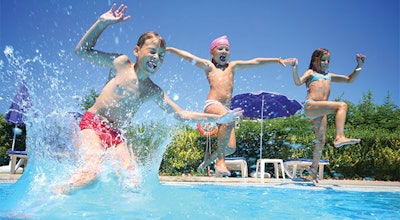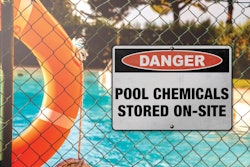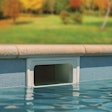
Certified EquipmentAutomated chemical controllers and pumping equipment should be certified, listed and labeled to NSF/ANSI 50 by an ANSI‐accredited certification organization; and where applicable UL 1081, UL 1563, CSA C22.2 No. 108, and CSA C22.2 No. 218. |
Accidental chlorine gas emissions can occur when the electrical interlock between the pool water circulation pump and the chemical feed system is lacking, improperly installed or simply fails. The risk of such a leak can be greatly reduced by designing a system to include adequate electrical interlock protection and incorporating several best practices for pool staff during pool maintenance.
HOW IT HAPPENS
When all is functioning correctly behind the scenes at pools with automated chemical control systems, chlorine-based disinfectant and acid are injected into the lines downstream from the filter. If the pool water circulation pump stops due to an unforeseen problem or for maintenance, and the chemical controller continues to add chlorine- based disinfectant and acid into the line, the two chemicals may react to form hazardous chlorine gas.
RELATED: Tech Notes: Wild Animals in the Water
Chlorine gas produced this way displaces pool water in the line, with the amount being proportional to the length of time the circulation pump is out of service and the chemical feeders are operating. When the pool water circulation pump is re-started and proper water circulation is restored, the chlorine gas is pushed through the line into the pool area where swimmers and staff may be exposed to hazardous levels. This scenario repeats itself several times each year in various locations, which prompted the American Chemistry Council and a group of public health and swimming pool industry representatives to develop a free YouTube training video to help prevent these unfortunate events (www.poolinterlocksafety.com). This article is based on information and guidance offered in the video.
ELECTRICAL INTERLOCK PROTECTION
Electrical interlock protection ensures that if the pool pump is disabled or loses prime (no flow situation), or there is any other loss or reduction of flow in the circulation system, the chemical feed equipment will also be disabled, avoiding the production of chlorine gas in the line. This shall be accomplished through an electrical interlock consisting of at least two of the following:
1. Circuit Breaker Design (Basic). Ensure the circulation pump and the chemical feed equipment are on the same electrical circuit. If the circuit powering the pump is tripped, power to the chemical feeders is also lost and there will be no injection of chemicals.
2. Pump or Filter Control. This method uses a basic three-way pump control panel with an AUTO/OFF/ HAND configuration. Ensure the chemical feed equipment is connected to only the AUTO function for pump control.
The pump should be backwashed only in HAND mode. If the switch is in the OFF or HAND mode, power to the chemical feeders is also lost and there will be no injection of chemicals. For systems using regenerative filtration or sand filtration with automatic backwash control, there are common relays that can be programmed to disable chemical automation during bump or backwash sequences.
RELATED: Tech Notes: Biguanide
Most variable speed drives can be programmed to enable or disable automated chemical controllers. Never connect chemical feed systems directly to power, or "hot," which bypasses the pump electrical interlock.
3. Float or Centrifugal Flow Switch. A float or centrifugal flow switch can be incorporated into the sample stream of the chemical controller, which samples water flow. When the sample stream loses flow, the switch signals the controller to stop the chemical feed.
4. Flow Switch or Electronic Flow Meter. A flow switch or electronic flow meter with signaling capabilities can be used in the main circulation system's return stream of water, indicating there is flow through the main system.
PRECAUTIONS
- A flow switch by itself provides insufficient protection, as it could fail and send a false indication of water flow when there is none. The flow switch should only be used as a backup to the electrical interlock between the water circulation pump and chemical feed system.
- The safety switch system should be installed and maintained according to the manufacturer's instructions, and not modified or bypassed in any way. Conduct an initial challenge test upon installing an interlock system.
- Conduct monthly challenge tests, including a backwash cycle at least once per month, to ensure the proper operation of the interlock safety switch, sensors and alarms. Basic interlock designs only react to electrical incidents, such as loss of power, and not to an inherent loss of water flow, which could be caused by something other than the loss of power.
- Basic protection can be lost if someone unknowingly unplugs the chemical feeder from the controlled circuit and plugs it into another circuit. An alarm should be activated whenever the chemical feeder is disabled through the interlock system to alert staff to evacuate the pool.
- Maintain proper labeling of all system components. Keep all signs, labels and placards up to date and legible. Use safety signs as reminders to take action under certain circumstances. Follow OSHA hazard communication plan requirements, including developing an emergency action plan.
POOL STAFF BEST PRACTICES
1. The aquatic venue should be closed and all bathers removed from the pool and deck whenever maintenance work is to be performed on the circulation and chemical systems.
2.The pool and deck area should be cleared immediately when:
- A flow sensor detects no flow in the system.
- An unexpected or manual deactivation of the circulation pump occurs.
- The interlock system is activated, indicating a problem with the flow system.
3. Bathers should not be allowed back into the aquatic venue until the cause of the interruption is understood and the condition is corrected. The system should operate correctly for at least five minutes before bathers return to the water.
4. Water should be tested for proper pH and free chlorine levels before bathers return to the water.
5. Train staff to recognize high‐risk scenarios that could lead to chlorine gas exposure, such as when water circulation ceases and when the electrical interlock and safety switch failure alert system is activated.











































